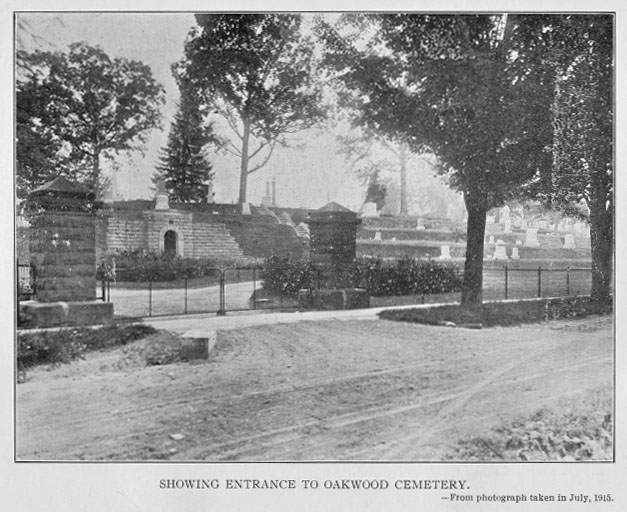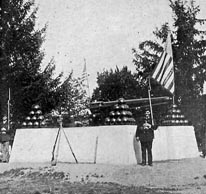Oakwood Cemetery Association
Cemetery Regulations
Cemetery News
Cemetery Map
Contacts
Links
Cemetery History
Family Research
Oakwood Folks and Families
Oakwood Photo Album
Friends of Nunda Cemeteries
Oakwood Sequicentennial
l865-2015
How You Can Help
Return to Main Page
|
Oakwood Cemetery History

Image taken from Oakwood Cemetery Association booklet, 1915
When the first burials were made at what is now Oakwood Cemetery, Nunda was a pioneer settlement on America's western frontier. Over the years generations of area families have brought their loved ones to Oakwood where they remain an important part of Nunda's story.
The links below will help you explore this historic place and the stories of the people who now rest here.
A Short History of Oakwood Cemetery
Also see our Oakwood Photo Album and Oakwood Folks & Families |

West Street Entrance, circa 1880
|
A
Short History
of
Oakwood Cemetery |
 Soldier's Monument 1903
Soldier's Monument 1903 |
As you walk among the stones in Oakwood Cemetery you are journeying through two hundred years of Nunda area history. The names you see tell the stories of five generations of local families whose stories are the history of the Town and Village of Nunda.
The cemetery was first opened in 1822 as the valley was first being settled by pioneers. The first burial at the “Oak Knoll” was that of 19 year-old Amy Tuttle. The next year the remains of Granny Prentice were carried to the graveyard on a sled pulled by oxen. Although the exact location of the these graves have has been lost, the Oak Knoll was in what is now known as OC1 (Old Cemetery 1) in the part of the cemetery. There you will find the graves of many other pioneers, the earliest stone dating to 1829.
As Nunda grew, so did the cemetery. By 1860 the grounds had expanded to include both OC1 and OC2. In 1864 the village raised a tax of $25 to improve the grounds and repair the fences that kept local livestock out of the burial plots. The very next year local citizens organized the Oakwood Cemetery Association, a private, not for profit organization to manage and maintain the cemetery.
The new Association purchased additional acres from the Upson and Osgoodby families, more than doubling the size of the cemetery. The plans for the new grounds (sections A through I) reflected the contemporary “garden cemetery” movement with its winding roadways and landscaped paths. These sections opened in 1866, but contain several older gravestones. Many local families paid the sexton, Samuel Reckard, $6.00 to move the a family member’s remains and their markers to the new sections.
The ornamental gateway on West Street which was added in 1878. This gateways was removed in the early 1900’s, but the original sign is preserved on the Cemetery tool shed near the Gibbs Street entrance. The Soldier’s Monument was dedicated in 1897 and the cemetery vault and steps were built in the first decade of the twentieth century. New sections were also added to the 1865 plans. Section J is said to have originally been the Catholic burial grounds, while Sections K and L contain the later twentieth century burials. In recent years the Association has bought five additional acres of land to the west of the cemetery on Price Street to allow for future expansions. Today you can still walk through the old “Oak Knoll” or trace the garden paths of the 1865 cemetery. Here are just a few of over four thousand stones and stories that can be found in Oakwood Cemetery:
- Family Plot of the Micah Brooks family. Micah was an early pioneer who knew Mary Jemison well. He also served as a Congressman and local land developer. (OC2)
- Whitcomb/Richmond Family Vault - the story of Anna Elizabeth Richmond, member of a prominent 19th century family, was chronicled in the book “My Dearest Anna.” (OC2)
- James Paine was the first permanent settler in the present lands of the town of Nunda. His descendants still live in the area. (Section B, east end near West St fence)
- John W Emmons was not yet 16 when he died of fever in the Union army during the Civil War. (west end of Section B)
- Richard Gay was a slave who escaped to the northern lines during the Civil War. He came north with the 1st NY Dragoons and lived out his life in Nunda.(east end section H)
- Rose Shave was a nationally known artists whose work can been seen at the Nunda Historical Society Museum. (east end of Section I)
For more information see the Nunda Historical Society web site, or visit Find a Grave. You will find the links here.
return to top |
|



